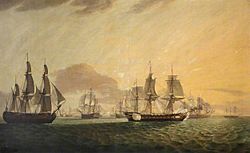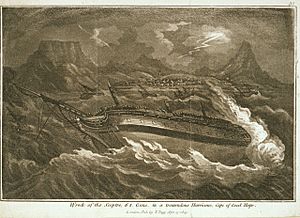HMS Sceptre (1781) facts for kids

Sceptre
|
|
Quick facts for kids History |
|
|---|---|
| Name | HMS Sceptre |
| Ordered | 16 January 1779 |
| Builder | Randall, Rotherhithe |
| Laid down | May 1780 |
| Launched | 8 June 1781 |
| Fate | Wrecked in Table Bay, 5 November 1799 |
| Notes |
|
| General characteristics | |
| Class and type | Inflexible-class ship of the line |
| Tons burthen | 1398 (bm) |
| Length | 159 ft (48 m) (gundeck) |
| Beam | 44 ft 4 in (13.51 m) |
| Draught | 5.7m |
| Depth of hold | 18 ft 10 in (5.74 m) |
| Propulsion | Sails |
| Sail plan | Full-rigged ship |
| Complement | 481 men in 1799 |
| Armament |
|
HMS Sceptre was a powerful warship of the Royal Navy. It was a 64-gun ship of the line, meaning it carried many cannons and was built for battle. The ship was launched on June 8, 1781, in Rotherhithe, England. Sadly, Sceptre was destroyed in a huge storm on November 5, 1799. This happened in Table Bay, near the Cape of Good Hope in South Africa.
Contents
Life of a Warship: HMS Sceptre's Journey
Soon after it was built, Sceptre sailed to the Indian Ocean. It joined a group of British warships led by Vice-Admiral Sir Edward Hughes. The ship arrived just in time for the Battle of Trincomalee in 1782. This was a major naval battle against a French fleet.
The next year, Sceptre fought in another big battle, the Battle of Cuddalore (1783). This was the last big fight in the East Indies campaign. Before this battle, Sceptre captured a French warship called Naïade. Naïade was a smaller ship, but it had 18 to 20 guns and 160 crew members. The British took Naïade but later sold it.
After these battles, Sceptre was put away during peacetime. This means it was kept in storage until it was needed again. In 1794, under the command of Commodore John Ford, Sceptre helped capture Port-au-Prince in Haiti.
On March 12, 1795, Sceptre sailed to the Cape of Good Hope. It was protecting a group of East Indiamen ships. These were large merchant ships that sailed to India and China.
Capturing Dutch Ships off St Helena
When Sceptre arrived at Saint Helena, it brought important news. France had invaded the Netherlands. Because of this, British ships were ordered to stop and hold any Dutch ships they found.
On June 2, 1795, a British ship called Swallow arrived. It brought news that a group of Dutch East Indiamen had left the Cape, heading for Europe. These ships were carrying valuable goods.
A group of 16 Dutch East Indiamen had left Table Bay on May 18, along with two escort ships. Bad weather forced eight of them back to the Cape. The other eight continued their journey.
Captain William Essington, who commanded Sceptre, decided to act. He convinced the governor of St Helena to lend him some soldiers. He also gathered British East India Company (EIC) ships that were at St Helena to form a squadron. One of these was the General Goddard, a large EIC ship.
On June 3, Sceptre, General Goddard, and Swallow set out to find the Dutch ships. On June 10, they captured a Dutch Indiaman called Hougly.
In the afternoon of June 14, Essington's squadron spotted seven ships. Early the next morning, the British ships approached the Dutch fleet. After a short exchange of fire, the Dutch ships surrendered. No one was hurt on either side. The British then brought the captured Dutch ships to St Helena.
The captured ships were very valuable. The British officers and crew of Sceptre and the other ships received a large amount of money for their efforts.
The Final Storm: Sceptre's Wreck
On November 5, 1799, Sceptre was anchored in Table Bay during a terrible storm. Captain Valentine Edwards was in command. At 10:30 AM, the captain ordered parts of the ship's masts and yards to be lowered. This was done to make the ship more stable in the strong winds.
Around midday, the ship even fired its guns in celebration of a holiday. This suggests no one expected the storm to become so dangerous. However, within half an hour, the main anchor cable broke. Even after a second anchor was dropped, that one broke too.
Around 7 PM, the ship was pushed onto a reef at Woodstock Beach. The powerful waves smashed the ship to pieces. About 349 sailors and marines were killed or drowned. Only 51 people were saved from the wreck, but nine of them died on the beach. Sceptre was wrecked very close to where a Danish warship, the Oldenborg, was also destroyed in the same hurricane.
Later, the surviving officers and crew had to go through a court martial. This was a standard procedure when a ship was lost. However, they were all found innocent, and no one was blamed for the loss of Sceptre. Interestingly, the captain of the Oldenborg managed to save all 446 men on his ship during the same storm.
Images for kids
-
A sketch of wreckage from Sceptre at Craig's Tower by Lady Anne Barnard




